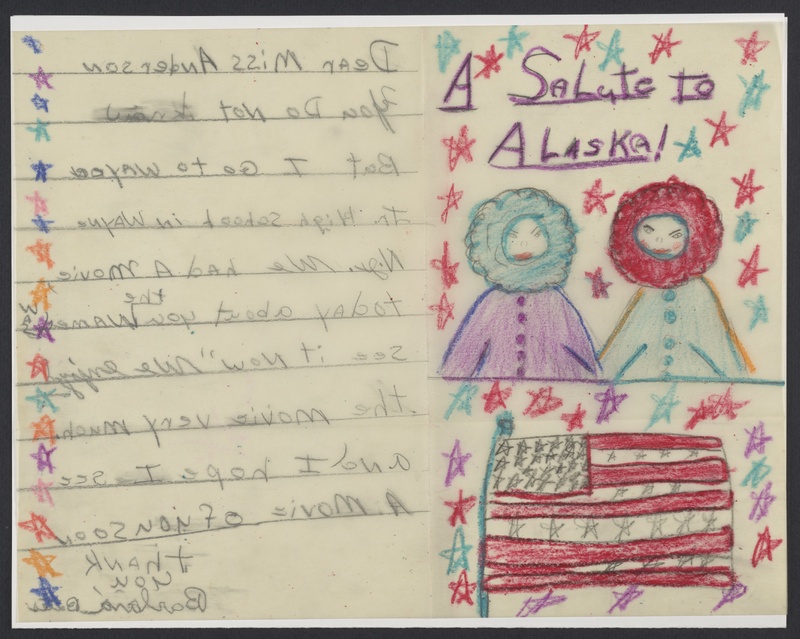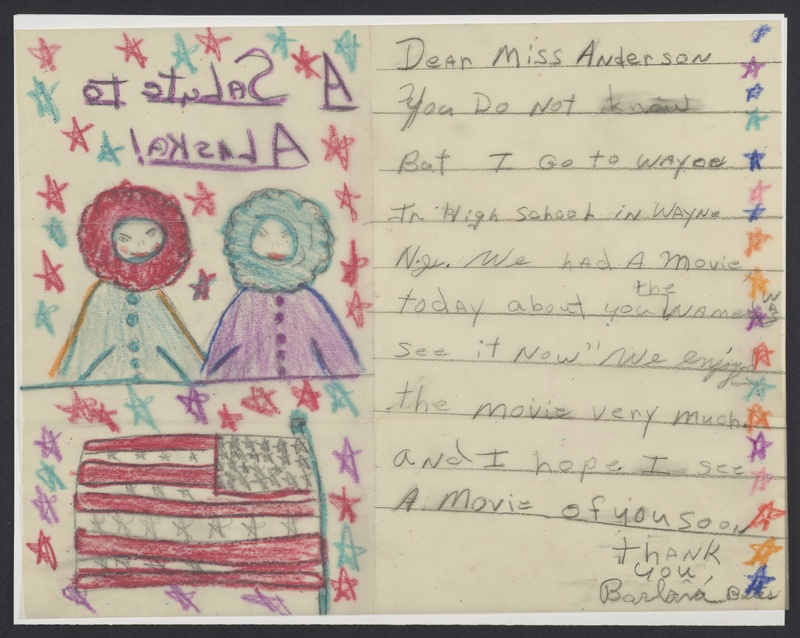Letter, Barlana Bates to Miss Anderson
Item
-
Title
-
Letter, Barlana Bates to Miss Anderson
-
Description
-
This letter was sent by Barlana Bates (c. 1942) to Marian Anderson (February 27, 1897-April 8, 1993) sometime after December 30th, 1957. The letter appears to have been drawn on tracing paper. The front of the card is very colorful, with an illustration drawn with crayon of two people in parkas above an American flag, and below text that reads “A Salute to Alaska!”
-
The CBS television series “See It Now” aired on that December 30th, 1957 (Penn Libraries 2016). This episode featured Marian Anderson’s recent tour through Asia, her speech at the Mahatma Gandhi memorial, and also some of her national and international performances (Penn Libraries 2016).
Barlana Bates stated in her letter that she attends high school in Wayne located in Steuben County, New York. The town has two lakes (Keuka Lake and Waneta lake) and is in New York’s beautiful Finger Lakes region (Town of Wayne 2025). Bates attended Hammondsport Central School District, about 12 minutes (8.5 miles) outside of Wayne, NY.
Marian Anderson was born and raised in South Philadelphia to John and Anna Anderson, and had two younger sisters (Penn Libraries, n.d.). She would grow up to reach international fame as a contralto classical singer, and symbol of success and resilience (Penn Libraries, n.d.). Her singing career began in her family’s church chorus, and she sang and studied music and performance at William Penn High School and South Philadelphia High School for Girls (Penn Libraries, n.d.). Her church, local organizations, and the greater Black community helped to financially support and advance her early educational journey (Penn Libraries, n.d.). These opportunities and connections propelled her to local and regional fame; having first performed at the Philadelphia Academy of Music in 1918 and with the New York Philharmonic in 1924 (Penn Libraries, n.d.). She studied the arts internationally, making her first trip to Europe in 1928 (Penn Libraries, n.d.). At first funded by foundations and scholarships who saw immense talent in her, Anderson would continue to tour and travel internationally through her career (Marian Anderson Museum, n.d.).
Anderson is appreciated for paving the way for future Black performers, as she was the first Black female to perform at Carnegie Hall in 1928, the first Black singer to perform at the Metropolitan Opera in 1955, and the first Black singer to perform at a Presidential Inauguration in 1957 (Marian Anderson Museum, n.d.). She experienced racism in the United States more than other countries, and gently protested this in ways such as insisting auditorium seating be integrated, and “refus[ing] to sing where the audience was segregated” (National Marian Anderson Museum, n.d.). In 1936, Anderson performed at the White House in Washington, D.C. In 1939, she was to perform again in D.C.– her manager Sol Hurok suggested that she perform at Constitution Hall, the capital’s largest concert hall seating up to 3,702 people (Daughters of the American Revolution, n.d.). It is operated by the Daughters of the American Revolution, and they denied her the opportunity to perform due to the color of her skin (Penn Libraries, n.d.; DAR Public Relations, n.d.). Instead, she performed on Easter for over 75,000 people (plus radio listeners) on the steps of the Lincoln Memorial (National Marian Anderson Museum, n.d.).
Anderson received a plethora of awards, appointments, and over fifty honorary degrees including: an honorary membership in Alpha Kappa Alpha; honorary degrees from Howard University, Temple University, Smith College, and more; NAACP Spingarn Medal in 1939; the Philadelphia Award established by Edward Bok of which was particularly meaningful to her in 1941; appointment to the National Council on the Arts in 1966; the United Nations Peace Prize in 1972; Congressional Medal by President Carter in 1978; as well as the Grammy Lifetime Achievement Award in 1991 (Penn Libraries, n.d.; Anderson 1955, pp. 273-275; Marian Anderson Museum, n.d.).
-
Marian Anderson - The Lady from Philadelphia, the See It Now TV Show
-
Penn Libraries Digital Collection on Marian Anderson
-
Rights
-
Copyright restrictions may exist. For most library holdings, the Trustees of the University of Pennsylvania do not hold copyright. It is the responsibility of the requester to seek permission from the holder of the copyright to reproduce material from the Kislak Center for Special Collections, Rare Books and Manuscripts.
-
Format
-
Text
-
Language
-
eng
-
Contributor
-
University of Pennsylvania: Kislak Center for Special Collections, Rare Books and Manuscripts
-
Extent
-
2 pages
-
Identifier
-
Ms. Coll. 200 Box 124
-
transcription
-
DeAr Miss ANdersoN
You Do Not know
But I Go to WAYne
In High School iN WAYNe
N.Y. We hAd A Movie
todAy about you the Name WAs
see it Now" We enjoyed
the movie very much.
aNd I hope I see
A Movie of you sooN
thANk
You,
Barlana Bates
A SALute to
ALASKa!
-
Subject
-
Anderson, Marian, 1897-1993.
-
Contraltos--United States--Biography.
-
Fan mail--United States.




